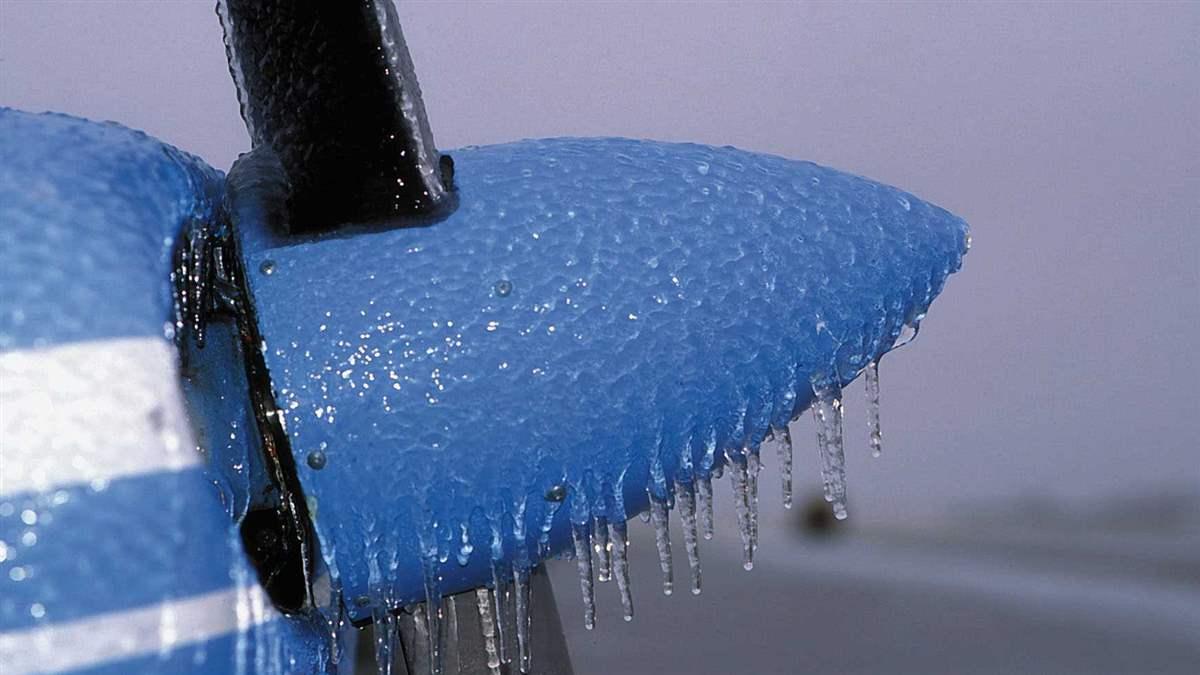Deicing and Anti-Icing Equipment
Safety SPOTLIGHT: Precipitation and Icing

Most light aircraft are poorly equipped to deal with icing conditions. Some may have partial equipment intended only for escaping unexpected icing conditions. Unless your aircraft is FAA certified for flight into icing conditions, you must avoid entering areas of known icing.
Even airplanes approved for flight into known icing conditions should not fly into severe icing.
Basic Anti-Icing Equipment
On most light GA aircraft basic anti-ice equipment to prevent ice from forming includes pitot heat, carburetor heat (if the engine is carbureted), and a windshield defroster.
Pitot Heat—It’s a good habit to always turn the pitot heat on before flying through visible moisture. If ice blocks the pitot tube the airspeed indicator will stop working properly. If the pitot tube drain hole also gets blocked, the airspeed indicator will act like an altimeter and erroneously show increased airspeed when the aircraft climbs.
Carburetor Heat/Alternate Air—Apply carburetor heat, which uses heat from the engine, to prevent or remove carburetor icing. For fuel-injected engines use the alternate air door if the primary air intake ices.
Windshield Defroster—Use the defroster to help prevent ice from forming on the windshield. Be aware that in moderate or greater icing conditions the defroster may not keep up with accumulation.
Advanced Anti-Icing Equipment

Windshield Anti-Ice—There are two systems used in light aircraft. An electrically heated windshield (or plate) or a fluid spray bar located just ahead of the pilot’s windshield.
Propeller Anti-Ice—Ice often forms on the propeller before it is visible on the wing. Props are treated with deicing fluid applied by slinger rings on the prop hub or with electrically heated elements on the leading edges.
Deicing Equipment
Deicing equipment removes structural ice after it forms. The two most common GA systems are inflatable boots and weeping wings. Weeping wings also can be considered anti-icing equipment if the fluid dispensing system is activated before ice accumulates.
Inflatable Boots—When activated, the inflatable rubber strips—attached to and conforming to the leading edge of the wing and tail surfaces—are pressurized with air and expand, breaking ice off the boot surfaces. Suction deflates the boots and they return to their original shape.
Weeping Wing—When activated, the deicing system pumps fluid from a reservoir through a mesh screen embedded in the leading edges of the wings and tail. The liquid flows all over the wing and tail surfaces, deicing as it flows. It can also be applied to the propeller and windshield.


FAA Certificated vs. Non-Hazard Systems
What’s the difference between systems that are FAA approved for flight in icing conditions, which allow a pilot to legally challenge routine icing conditions, and “non-hazard” systems that do not? Basically: certification standards and testing. Approved systems have demonstrated that they can protect your airplane during icing conditions specified in the airworthiness regulations, while non-hazard systems do not have that burden of proof. In the case of non-hazard systems installed on airplanes certificated before 1977, non-hazard systems weren’t even required to prove that they could shed ice!
Deicing equipment removes structural ice after it forms.
Comparison of Non-Hazard vs. Approved Systems:
| Requirements | Non-hazard System | Approved for Flight in Icing Conditions System |
|---|---|---|
| Stall warning heat | Not Required | Required |
| Reliability standards (redundant power sources) | Not Required | Required |
| Critical area protection | Not Required | Required |
| Shown to perform intended function | Required | Required |
System safety analysis
|
Not Required Required |
Required Required |
| Electromagnetic interference testing | Required | Required |
Fluid reservoir capacity requirements (e.g.,150 min. @ normal flow rate)
|
Not Required Not Required |
Required Required |
| Propeller thrust not affected by icing | Not Required | Required |
| Air data (pitot, static, angle of attack, stall warning) and other systems function normally in icing | Not Required | Required |
| Icing system function annunciation | Not Required | Required |
| Testing to show that the airplane has adequate performance, stability, controllability, stall warning, and stall characteristics for expected ice accretions | Not Required | Required |
| Susceptibility to ice shedding damage | Not Required | Required |
| Certified for flight in freezing drizzle or freezing rain | NO freezing drizzle or freezing rain | NO freezing drizzle or freezing rain |
Accident Case Study: Delayed Reaction
This video pieces together the events that led to the tragic loss of an entire family and discusses what we as pilots can learn from them.
